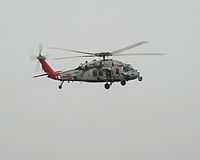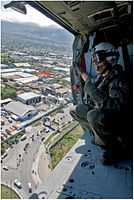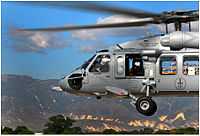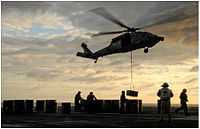HSC-9
| Helicopter Sea Combat Squadron Nine | |
|---|---|
 HSC-9 Emblem | |
| Active | June 1, 1956 - present |
| Country |
|
| Branch |
|
| Type | Navy Helicopter Squadron |
| Role |
Anti-Surface Warfare (ASUW) Combat Search and Rescue CSAR Search and Rescue (SAR) Special Operations (SpecOps) Vertical Replenishment (VERTREP) |
| Part of |
Commander, Helicopter Sea Combat Wing Atlantic |
| Garrison/HQ |
|
| Nickname | "Tridents" |
| Colors | Black and Red |
| Engagements |
Operation Enduring Freedom Operation Iraqi Freedom Global War on Terror |
| Commanders | |
| Current commander |
|
Helicopter Sea Combat Squadron Nine (HSC-9) "Tridents" is a United States Navy helicopter squadron based at Naval Air Station Norfolk, Norfolk, Virginia. HSC-9 is attached to Carrier Air Wing Eight and deploys aboard USS George H.W. Bush (CVN-77). HSC-9 was redesignated from HS-3 on 1 June 2009.
Mission
Helicopter Sea Combat Squadron Nine's primary mission is to employ the versatility of the MH-60S helicopter to support the battle group commander's objectives, with emphasis on Anti-Surface Warfare (ASUW), Combat Search and Rescue (CSAR), support of Special Operations, and Vertical Replenishment (VERTREP). Secondary missions include Anti-Ship Missile defense and Medical Evacuation (MEDEVAC).
HSC-9 command history
Early history
HSC-9 traces its history back to Helicopter Antisubmarine Squadron Three (HS-3) which was established 18 June 1952, at the Naval Air Facility, Elizabeth City, North Carolina. The Tridents commenced operations flying the Piaseki UH-25B helicopter, and later transitioned to the Sikorsky H-19 and SH-34 helicopters. HS-3 was the first Atlantic Fleet operational squadron to operate the gas turbine powered SH-3A Sea King, followed later by the SH-3D, and finally the SH-3H TACNAV equipped helicopter. Additionally in 1982, HS-3 became the first squadron to deploy with the AQS-13E Sonar Data Computer.
During the early 1960s HS-3 was deployed in USS Valley Forge (CVS-45) and USS Intrepid (CVS-11). In 1962, on board the USS Wasp (CVS-18), HS-3 participated in the naval blockade of Cuba.
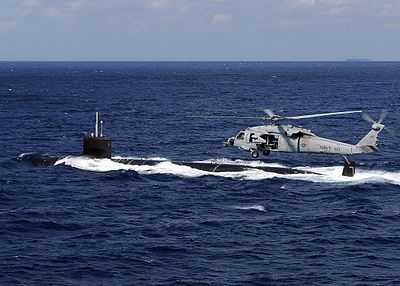
The Tridents began an active role in the space program on May 24, 1962 when then Skipper CDR J. M. Wondergem picked up LCDR M. S. Carpenter from his Aurora 7 spacecraft and delivered him to USS Intrepid (CV 11). Astronauts Carpenter, Grissom, Young, Collins, Gordon, Conrad, McDevitt, Scott, and Schweikart all ended their space journeys with rides aboard TRIDENT helicopters.
In 1967, HS-3 deployed aboard USS Randolph (CVS-15), and in 1970 the Tridents conducted their first operations aboard USS Forrestal (CVA-59). In the early 1970s, the squadron participated in the relief of Tunisian flood victims, rescuing or relocating 630 people while transporting over 43,000 pounds of food and medical supplies. In recognition of this humanitarian support, the squadron was awarded the Meritorious Unit Commendation. HS-3 won the Battle "E" in 1973 and 1978 as well as the Isbell Trophy in 1974 and 1978.
HS-3 was awarded two Navy Unit Commendations for operational accomplishments and outstanding maintenance efforts during the 1985-86 Mediterranean and Indian Ocean deployment on board USS Saratoga (CV 60). The Tridents won three consecutive Battle "E" Awards for 1985, '86 and '87. They also won back-to-back Isbell Trophies in 1986 and '87.
Seahawk history
In 1990, the Tridents enforced United Nations sanctions against Iraqi trade while deployed on board the USS Saratoga (CV-60) in the Red Sea. HS-3 conducted an actual Helicopter Visit, Board, Search and Seizure (HVBSS) with a special forces boarding team to "take down" a hostile merchant ship during Operation Desert Shield/Storm. HS-3 provided superb combat support in this campaign and was awarded a Navy Unit Commendation for those efforts. The squadron returned home in the spring of 1991 and was the first Atlantic squadron to transition to the SH-60F Seahawk.
Preparations for the squadron's 1995 Mediterranean deployment were interrupted when the Tridents were called on to support Operation Uphold Democracy during the military intervention in Haiti. HS-3 provided the sole Navy Maritime SAR, CSAR and special operations support. The Tridents deployed one week after the completion of Uphold Democracy and flew in support of Operation Deny Flight over Bosnia-Herzegovina. During this deployment, HS-3 also flew the first actual CSAR mission by an HS squadron since the Vietnam Era to search for the crew of a downed French Mirage fighter.
The Tridents deployed aboard USS Theodore Roosevelt (CVN-71) in March 1999 and headed straight into the first of two conflicts. During Operation Noble Anvil, HS-3 supported combat operations against Serbia in Kosovo. Once a cease-fire was agreed upon, the Theodore Roosevelt transited the Persian Gulf to support maritime interdiction operations and enforce no-fly zones over southern Iraq. In August, HS-3 conducted a successful HVBSS to a freighter violating UN sanctions. The operation seized $3.5 million in Iraqi contraband. During this demanding deployment, HS-3 lifted over 1,800,000 pounds of cargo and completed over 2,000 small deck landings. HS-3 was awarded the Battle "E" for 1999.

In April 2001, HS-3 deployed in USS Enterprise (CVN-65), which became the key force behind the highly successful first strikes against the Taliban in response to the terror attacks on the World Trade Center and the Pentagon. The Tridents conducted sustained CSAR, ASW, Logistics, NSW, and SAR operations in support of Operation Enduring Freedom.
The Tridents deployed in 2003 in the USS Theodore Roosevelt (CVN-71) after a compressed inter-deployment readiness cycle. During the course of the deployment, HS-3 conducted ASW, Logistics, and SAR operations in support of Operation Iraqi Freedom. After returning home in May, the Tridents continued their operational tempo in a surge status until January 2004.
In September 2008, after completing a lengthy training cycle, the Tridents deployed in USS Theodore Roosevelt (CVN-71) to the Arabian Sea in support of combat operations in Afghanistan. Along the way, HS-3 took part in a historic visit to Cape Town, South Africa. The Theodore Roosevelt was the first U. S. carrier to visit Cape Town in over 40 years. The Tridents ensured the success of the cooperative engagement with the South African government by transporting dignitaries on and off the ship, conducting an emergent 80,000 pound at-anchor vertical replenishment, and moving supplies for the reception ashore.
Once arriving on-station in the CENTCOM AOR, the Tridents flew plane guard, anti-terrorism force protection, anti-surface warfare, logistics, and anti-submarine warfare in direct support of Operation Enduring Freedom and maritime security operations during the 2008-2009 deployment. The Tridents also detached three H-60H aircraft to the USS San Antonio (LPD-17) and subsequently to the USNS Lewis and Clark (T-AKE-1) for two months. This detachment supported Combined Task Force 151 counter-piracy operations in the Gulf of Aden. The Tridents assisted in apprehending 16 suspected pirates and paved the way for future operations in the region. In 2008, HS-3 won the CNAF Aviation Battle Efficiency, Commander, Naval Aviation Safety Center Safety "S", and the CAPT A. J. Isbell Trophy.
Post MH-60S transition
On April 16, 2009, the Tridents returned home to Jacksonville, Florida, from HS-3's final cruise. During this year, the Tridents received the Jimmy Thach award for excellence in Anti-Submarine Warfare, a great end cap to the distinguished legacy of HS-3. In May, the squadron started its permanent duty station change to Norfolk, VA and airframe change to the MH-60S. On June 1, 2009, the Tridents officially became Helicopter Sea Combat Squadron NINE (HSC-9).
| HSC-9 MH-60S operations | ||||||||||||
|---|---|---|---|---|---|---|---|---|---|---|---|---|
| ||||||||||||
On 13 January 2010, the Tridents sent two helicopters in support of Operation Unified Response, providing humanitarian aid and disaster relief following the devastating Haiti earthquake. Squadron personnel spent three months deployed in USS Carl Vinson (CVN-70) and USS Bataan (LHD-5) off the coast of Haiti, delivering over 280,000 pounds of disaster relief supplies and completing 240 MEDEVAC missions on the beleaguered island. The Tridents also brought ashore over 556,000 pounds of sustainment supplies and made 1300 passenger transfers in support of the Operation.
Following their transition, Tridents lent support to numerous carrier qualifications and completed an intense work-up schedule in preparation for the USS George H.W. Bush (CVN-77) maiden voyage with Carrier Air Wing Eight.
Former commanding officers
| 1950s | |||||
|---|---|---|---|---|---|
| CDR Francis H. McClannan | June | 1952 | to | June | 1953 |
| CDR J. R. Wilson | June | 1953 | to | February | 1955 |
| CDR A. H. Willis | February | 1955 | to | April | 1956 |
| CDR Forrest H. McClannan | April | 1956 | to | March | 1957 |
| CDR F. H. Hollowell | March | 1957 | to | March | 1958 |
| CDR E. K. Larkin | March | 1958 | to | March | 1959 |
| CDR R. G. Amme | March | 1959 | to | March | 1960 |
| 1960s | |||||
| CDR W. L. Bennett | March | 1960 | to | March | 1961 |
| CDR A. H. Munson | March | 1961 | to | March | 1962 |
| CDR J. M. Wondergem | March | 1962 | to | January | 1963 |
| CDR J. C. Wilkins | January | 1963 | to | January | 1964 |
| CDR K. L. Morse | January | 1964 | to | December | 1964 |
| CDR J. T. Carter, Jr. | December | 1964 | to | December | 1965 |
| CDR E. N. Bouffard | December | 1965 | to | November | 1966 |
| CDR R. A. Miller | November | 1966 | to | September | 1967 |
| CDR M. J. Twite, Jr. | September | 1967 | to | June | 1968 |
| CDR G. M. Rankin, Jr. | June | 1968 | to | May | 1969 |
| CDR W. A. Domingue | May | 1969 | to | May | 1970 |
| 1970s | |||||
| CDR S. R. Snyder | May | 1970 | to | May | 1971 |
| CDR W. H. Winchester | May | 1971 | to | May | 1972 |
| CDR U. W. King | May | 1972 | to | April | 1973 |
| CDR W. H. Pharis | April | 1973 | to | May | 1974 |
| CDR F. C. Brockhausen | May | 1974 | to | June | 1975 |
| CDR R. A. Fisher | June | 1975 | to | October | 1976 |
| CDR J. M. Quarterman, Jr. | October | 1976 | to | January | 1978 |
| CDR B. A. Spofford | January | 1978 | to | April | 1979 |
| CDR H. E. Perry | April | 1979 | to | June | 1980 |
| 1980s | |||||
| CDR P. L. Nelson | June | 1980 | to | September | 1981 |
| CDR P. D. McGovern | September | 1981 | to | November | 1982 |
| CDR H. W. Nesbitt | November | 1982 | to | May | 1984 |
| CDR M. J. Panchura, Jr. | May | 1984 | to | October | 1985 |
| CDR S. L. Fahrenkrog | October | 1985 | to | March | 1986 |
| CDR L. L. Fitzgerald | March | 1986 | to | July | 1988 |
| CDR J. Hrenko, Jr. | July | 1988 | to | November | 1989 |
| 1990s | |||||
| CDR T. F. Darcy | November | 1989 | to | December | 1990 |
| CDR J. P. Avveduti, Jr. | December | 1990 | to | October | 1992 |
| CDR G. W. Faber | October | 1992 | to | January | 1994 |
| CDR J. H. Thompson | January | 1994 | to | March | 1995 |
| CDR R. H. Magee | April | 1995 | to | August | 1996 |
| CDR C. P. Bourne | August | 1996 | to | October | 1997 |
| CDR E. W. Dobson, Jr. | October | 1997 | to | January | 1999 |
| CDR J. S. Husaim | January | 1999 | to | March | 2000 |
| 2000s | |||||
| CDR G. A. Chamberlain | March | 2000 | to | June | 2001 |
| CDR L. W. Schonenberg | June | 2001 | to | October | 2002 |
| CDR J. B. Hopkins II | October | 2002 | to | February | 2004 |
| CDR S. W. Holmes | February | 2004 | to | April | 2005 |
| CDR T. J. Fitzgerald | April | 2005 | to | June | 2006 |
| CDR M. R. Moore | June | 2006 | to | September | 2007 |
| CDR M. A. Truluck | September | 2007 | to | December | 2008 |
| CDR S. B. Starkey | December | 2008 | to | April | 2010 |
| 2010s | |||||
| CDR W. T. Cox, Jr. | April | 2010 | to | July | 2011 |
| CDR B. K. Pummill | July | 2011 | to | October | 2012 |
Squadron aircraft
- Piaseki UH-25B helicopter
- Sikorsky H-19
- SH-34 helicopters
H-3 Sea King
- SH-3A
- SH-3D,
SH-60 Seahawk
- SH-60F, 1991–2009
- HH-60H, 1991–2009
- MH-60S, 2009–present (redesignated HSC-9 in 2009)
Squadron awards
SAR Excellence Award
"Golden Wrench" Maintenance Award
2012 "Battle E"
Ships deployed aboard
- USS Valley Forge (CVS-45)
- USS Intrepid (CVS-11)
- USS Wasp (CVS-18)
- USS Randolph (CVS-15)
- USS Forrestal (CVA-59)
- USS Saratoga (CV-60)
- USS Theodore Roosevelt (CVN-71)
- USS Enterprise (CVN-65)
- USS San Antonio (LPD-17)
- USNS Lewis and Clark (T-AKE-1)
- USS Carl Vinson (CVN-70)
- USS Bataan (LHD-5)
- USS George H.W. Bush (CVN-77)
- USNS Sacagawea (T-AKE-2)
See also
|
- CVW-8
- History of the United States Navy
- Helicopter Squadrons
- SH-60 Seahawk
References
External links
| |||||||||||||||||||||||||||||||||||||||||||||||||||||||||
